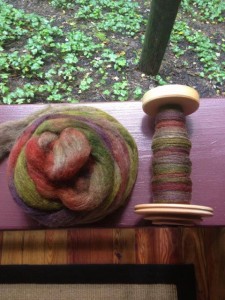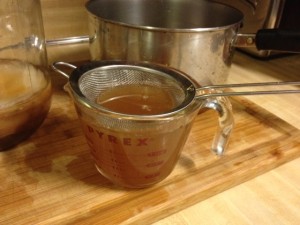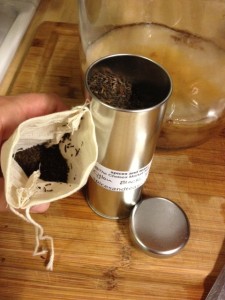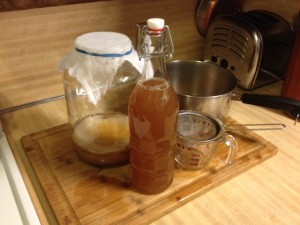Episode 4
This week’s episode features the following segments: Backstory, A Little Bit of Learning, Ever-expanding Skill Set, and Gratitude Journal.
 Since Episode 3, I have been working on intentional spinning. Here is half of my mixed BFL (bluefaced leicester) from Beesybee Fibers. Hopefully next week I can report on yardage. This fiber certainly has been a joy to spin. The colors are lovely earth tones. I’ve been spinning on the porch of Yin Hoo, watching the first orange leaves come floating down from the canopy. When I need a break from spinning, I look for the heron’s elegant form at the edge of the creek. We’ve seen as many as nine female Merganser swimming together and we have seen a few different bears walking along the path along the water’s edge.
Since Episode 3, I have been working on intentional spinning. Here is half of my mixed BFL (bluefaced leicester) from Beesybee Fibers. Hopefully next week I can report on yardage. This fiber certainly has been a joy to spin. The colors are lovely earth tones. I’ve been spinning on the porch of Yin Hoo, watching the first orange leaves come floating down from the canopy. When I need a break from spinning, I look for the heron’s elegant form at the edge of the creek. We’ve seen as many as nine female Merganser swimming together and we have seen a few different bears walking along the path along the water’s edge.
As promised in Episode 1, I’ve recorded a segment with my steps for making kombucha. In June, I received a scoby from my friend Gwen, and have been practicing all summer. Finally, I have a refreshing, effervescent, not-too-sweet fermented tea. Instructions for kombucha begin at twelve and a half minutes into the podcast.
 Begin by pouring off and straining kombucha. Always leave a small amount of tea in the fermentation container with the scoby (symbiotic colony of bacteria and yeast). I’ve been fermenting mine for 10 to 14 days before preparing a new batch. I store the brew in swing top bottles in the fridge. Be sure to use food-grade glass for both fermentation and storage. Make a new batch of tea by boiling one gallon of filtered water.
Begin by pouring off and straining kombucha. Always leave a small amount of tea in the fermentation container with the scoby (symbiotic colony of bacteria and yeast). I’ve been fermenting mine for 10 to 14 days before preparing a new batch. I store the brew in swing top bottles in the fridge. Be sure to use food-grade glass for both fermentation and storage. Make a new batch of tea by boiling one gallon of filtered water.
 Add about 3/4 cup of sugar and stir to dissolve. Remove the pan from heat and add 6-10 bags of black tea, or 6-10 tablespoons of loose black tea. Allow to steep for 5 minutes and then remove the tea bags or strain the tea. I put loose tea into a small cloth bag that acts as a tea bag. When tea has completely cooled, pour it into the container with the scoby. Sometimes this disturbs the scoby. I handle my scoby with clean hands. Keep the smooth, white surface of the scoby facing upwards. Cover the fermentation container with cheesecloth and store in a cool, dark place. Those who praise the benefits of kombucha usually mention its probiotic properties. I’d love to hear from you if you make kombucha at home or have a great recipe to try.
Add about 3/4 cup of sugar and stir to dissolve. Remove the pan from heat and add 6-10 bags of black tea, or 6-10 tablespoons of loose black tea. Allow to steep for 5 minutes and then remove the tea bags or strain the tea. I put loose tea into a small cloth bag that acts as a tea bag. When tea has completely cooled, pour it into the container with the scoby. Sometimes this disturbs the scoby. I handle my scoby with clean hands. Keep the smooth, white surface of the scoby facing upwards. Cover the fermentation container with cheesecloth and store in a cool, dark place. Those who praise the benefits of kombucha usually mention its probiotic properties. I’d love to hear from you if you make kombucha at home or have a great recipe to try.
“What is a teacher?
I’ll tell you; it isn’t someone who teaches something, but someone who inspires the student to give her best in order to discover what she already knows.” — Paulo Coelho


You do have a soothing voice, Sara! As a former teacher, I thoroughly enjoyed your learning/teaching episode, and you’re thoroughly inspired me to work my way up to a home brewed batch of hooch.